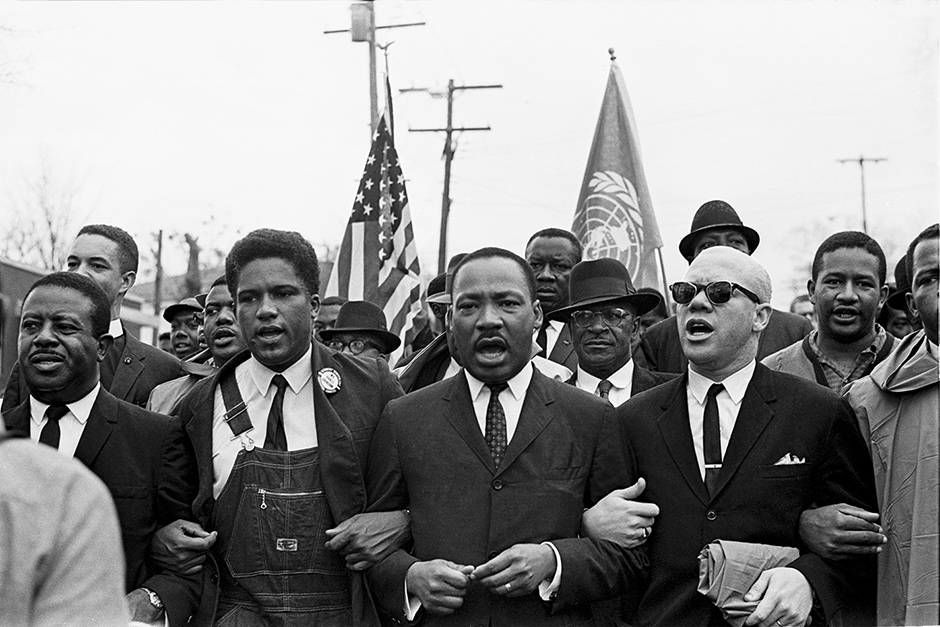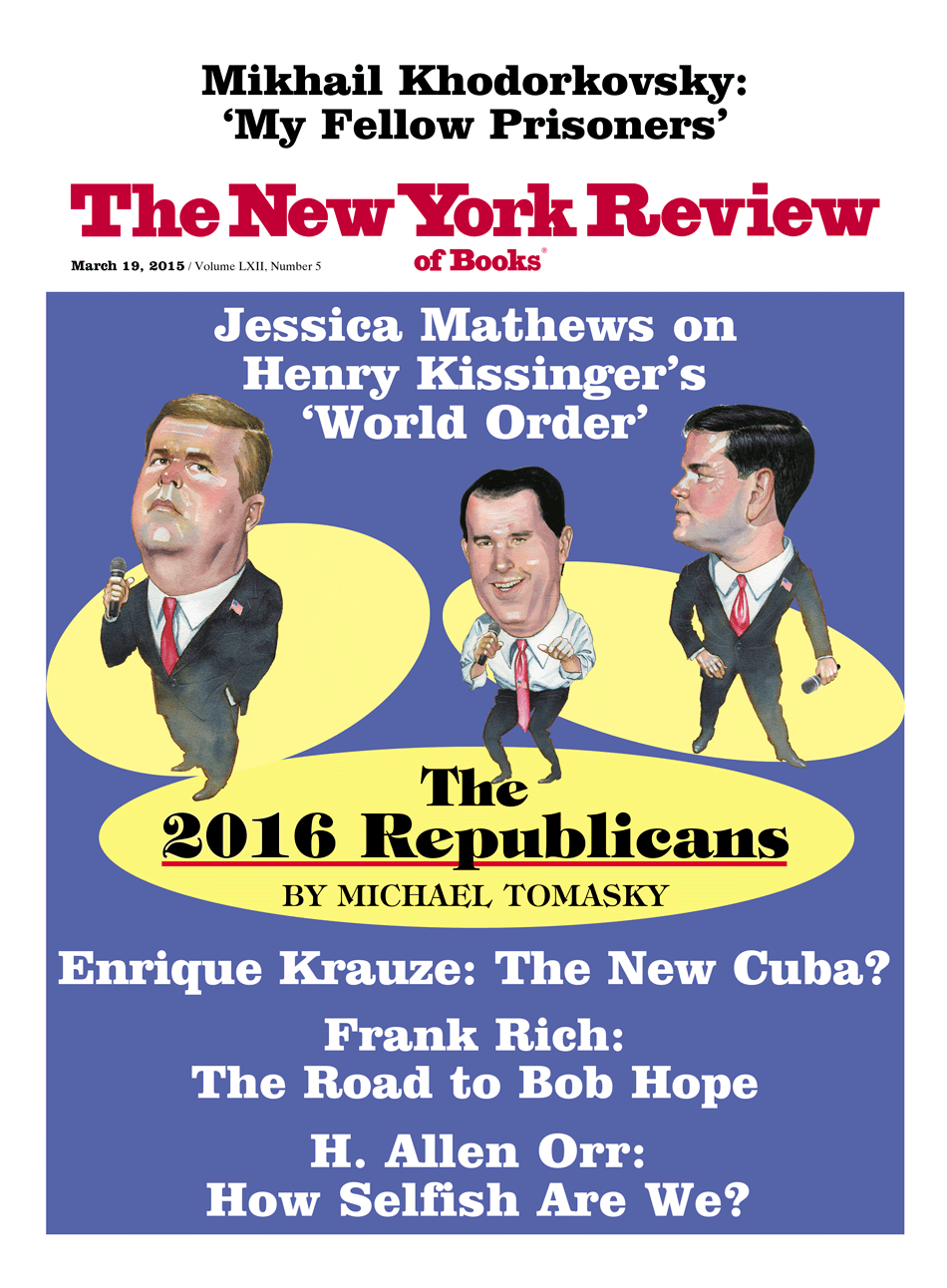In response to:
Some Different Ways of Looking at Selma from the February 19, 2015 issue

Steven Kasher Gallery, New York
Martin Luther King Jr. with Ralph Abernathy, James Forman of the SNCC, and Reverend Jesse Douglas leading the march around the state capitol, Montgomery, Alabama, March 25, 1965; photograph by Spider Martin from the exhibition ‘Selma March 1965,’ at the Steven Kasher Gallery, New York City, March 5–April 18, 2015
To the Editors:
I have great respect for The New York Review of Books. Thus, I turned with anticipation to Darryl Pinckney’s recent piece on Selma, the event itself and the movie that depicts what happened [“Some Different Ways of Looking at Selma,” NYR, February 19]. I did this from the perspective of someone who, as an assistant to Senator and Vice President Hubert H. Humphrey, was closely involved with the development and passage of the Civil Rights Act of 1964 and the Voting Rights Act of 1965.
I regret to say that I was disappointed and puzzled. How is one to explain the series of factual errors I encountered? It’s Sheriff Jim Clark—Selma’s still-notorious brutal bully—not “Bill” Clark. Mr. Pinckney writes that King’s activist leader, James Bevel, was moved to action by the horrendous murder of Jimmy Lee Jackson of Selma. That’s misleading because Bevel and his wife, Diane Nash, had developed the so-called Alabama Plan that included direct action in Selma, as well as other Alabama cities, almost two years earlier in the aftermath of the murder of the four schoolgirls at the 16th Street Baptist Church in Birmingham.
In other words, Selma’s demonstrations were a long time in the making. In another misstep, Mr. Pinckney has Sheriff Jim Clark ordering the state troopers to stand aside during the “Turnaround Tuesday” second march that is so dramatically depicted in the film. Not so. Sheriff Clark was deliberately kept under wraps by state authorities and played no role. It was Major John Cloud of the Alabama state troopers, acting on orders from Colonel Al Lingo who, in turn, was communicating with Governor George Wallace, who commanded the troopers to move to the side of the highway.
This is significant because the standdown to avoid violence had been negotiated by White House representatives, King, and Lingo. Even though it generated heated opposition from the Student Non-Violent Coordinating Committee toward King, this agreement also kept the marchers from violating an injunction by the federal district court not to march until the federal district judge had reached a positive decision on whether the march could go forward. The entire episode revealed a growing and ultimately decisive collaboration—a partnership, if you will—between Reverend King and President Johnson.
These missteps point to another and more fundamental concern: Where is the insight that Mr. Pinckney could bring to the current debate about the significance of historical accuracy in cinematic portrayals of controversial past events? True, Mr. Pinckney acknowledges that President Johnson was not the obstacle depicted by the film’s director, Ava DuVernay, and he quotes from well- regarded black leaders to support this characterization. DuVernay, on the other hand, has a different perception of reality, as reflected in her comment that she wasn’t interested in making another “white savior movie.”
Mr. Pinckney’s take on these divergent realities would have been very illuminating. For instance, he could have tackled the question that continues to swirl about this powerful film: How much credence are we to afford the notion that filmmakers can, and should, define distinctly different white and black narratives?
Here’s what I think. Passage of the Voting Rights Act was one of the momentous democratic achievements of the last century. It represented an enormous first step in correcting injustices that have plagued—and continue to plague—our democracy from before independence. Neither Lyndon Johnson with all his legislative experience and protean energy nor Martin Luther King Jr. with all his eloquence, personal charisma, and organizational skills could win this fight on his own. No question that King kept pushing Johnson and it’s equally clear that Johnson kept telling King about the political and legislative barriers that had to be overcome. Both also came to realize that together they could win and apart they would lose. Anything that detracts from the essential truth of this realization is regrettable.
With a commitment to preserving essential truths, the filmmaker can capture stories like Selma in a manner beyond the reach of any other medium. Pinckney, on the other hand, prefers another path:
The book is still the only medium in which you can make a complicated argument…. But for the black experience, the word is still chief witness. Selma was the worst place in the world, James Baldwin said.
With due respect to both Darryl Pinckney and James Baldwin, understanding the “Selma” phenomenon—in reality and on film—requires a lot more than this.
John G. Stewart
Legislative Director to Senator Hubert Humphrey (1962–1965) and to Vice President Humphrey (1965–1969)
Knoxville, Tennessee
Advertisement
To the Editors:
Darryl Pinckney adds his voice to the reviews of the movie Selma and supplements his comments by relating aspects of King’s campaign not covered by the film. Selma has been observed and written about regularly since 1965. The movie and the fiftieth anniversary of “Bloody Sunday” have only increased that attention. Those of us who live here have learned to live with that. We can point out errors in what is said about us, such as those that occur in the movie and Mr. Pinckney’s review (Sheriff “Bill” Clark instead of Jim Clark). But it seems trivial to do so when the basic truth of discrimination and violence that happened in 1965 is so powerful.
Nevertheless, for Mr. Pinckney to conclude his piece by quoting an offhand remark by James Baldwin that “Selma was the worst place in the world” is hard to take. This gratuitous swipe at our town is not related to the movie or the review, and furthermore the statement was untrue in 1965 and is certainly untrue now. Selma in 1965 was guilty of Jim Crow prejudice and denial of voting rights of its citizens, as were hundreds of towns and cities all over the South. But Selma had removed segregation signs from public drinking fountains and begun interracial meetings. Selma’s leading citizens had publicly denounced the Ku Klux Klan.
What Selma did have was a brutish sheriff who reacted violently once the marchers got to the courthouse or across the bridge into the county and under his jurisdiction. But the city of Selma had its public safety director, Wilson Baker, who kept the peace while the marchers were under his watch. Under very difficult circumstances, he prevented matters from getting much worse. The violent actions that resulted in the death of Jimmy Lee Jackson did not occur in Selma by the Selma police as the movie implies, but in another town by state troopers.
As a white Selmian who was here in Selma in 1965, I am not proud of the fact that those of us who were opposed to Jim Clark and George Wallace did not speak out more strongly. I am pleased, however, that as a very young lawyer, I was asked to represent Wilson Baker when he ran against Jim Clark for sheriff in 1966 after the Voting Rights Act was passed. Baker had strong support in the white community and virtually all of the black support. When Clark saw he was going to lose, he confiscated seven or eight boxes from the predominantly black voting districts, declaring them illegal for irregularities. Fortunately, the resulting election contest was removed to federal court, and John Doar arrived to try the case and obtain a verdict for Baker.
Selma now suffers from more than its share of poverty and lack of economic opportunity. Racism, from both white and black, still exists to some degree. But there are many positive signs, and many examples of cooperation and goodwill between the races. There are numerous events taking place over the next several weeks and months, including a “unity” march from the county side of the bridge back into town, a panel discussion with Howell Raines and others, and a visit from President Obama. Selma has budding entrepreneurial and arts movements making a difference in the community. A novelist of Mr. Pinckney’s stature would be a welcome addition to the dialogue. I invite him to come on down.
Harry W. Gamble Jr.
Selma, Alabama
Darryl Pinckney replies:
I do make apologies to Mr. Stewart and to all readers for the error of calling Sheriff Jim Clark “Bill” Clark and for attributing the order to withdraw on Turnaround Tuesday to him, when it was the head of the state troopers who gave the order. It may be clear in the film; I should have gone to see it a third time. I should have checked the several documentary sources available. But I don’t consider these factual errors “missteps.”
I didn’t go into Bevel’s “Alabama Plan,” because the film doesn’t. I also don’t see where Mr. Stewart and I disagree on the importance of the Voting Rights Act, or on how much Johnson and King needed each other to get it passed.* He’s certainly entitled to feel vehemently about the film, but that is a matter altogether separate from what I said about the story this biopic takes from the Selma protest.
I am pleased for Mr. Gamble that his feeling for his hometown inspires him to speak up for those white citizens in Selma who tried to make a difference or recognized that change had to come. But there was nothing offhand or gratuitous about what Baldwin said. Selma was for him a very disturbing experience, a black man from the North accustomed to the harshness of the ghetto, but not to the organized violence of those opposed to civil rights equality in the South. He hadn’t liked being afraid. Some time after Selma, Baldwin wrote about his color being a mirror for white people and therefore he had to spend a great deal of energy reassuring them that they did not see what they saw.
Advertisement
-
*
This mutual effort was discussed at length in Elizabeth Drew’s “Selma vs. History,” NYRblog, January 8, 2015. ↩


